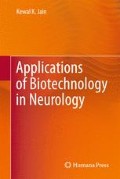Abstract
Neuroprotective agents aim to prevent neuronal death by inhibiting one or more of the pathophysiological steps in the processes that follow brain injury or ischemia due to occlusion of a cerebral artery. They also protect against neurodegeneration and neurotoxins. Application of new molecular technologies to dissect pathways and unravel mechanisms involved in damage to the nervous system are providing bases for development of new neuroprotective agents for diseases, which are currently treated by drugs that merely provide symptomatic relief. The topic is described in detail in the Handbook of Neuroprotection (Jain 2011). The concept of neuroprotection is now incorporated in development of drugs for neurologic disorders and more than 500 such approaches are in development including several that are based on biotechnology. For developing new neuroprotective strategies, it is important to understand the intrinsic neuroprotective factors in the human body.
Access this chapter
Tax calculation will be finalised at checkout
Purchases are for personal use only
References
Brunori M, Giuffre A, Nienhaus K, et al. Neuroglobin, nitric oxide, and oxygen: Functional pathways and conformational changes. PNAS 2005;102:8483–8.
Brunori M, Vallone B. A globin for the brain. FASEB J 2006;20:2192–7.
Chen L, Stone MC, Tao J, Rolls MM. Axon injury and stress trigger a microtubule-based neuroprotective pathway. Proc Natl Acad Sci USA 2012;109:11842–7.
Dhandapani KM, Wade FM, Wakade C, et al. Neuroprotection by stem cell factor in rat cortical neurons involves AKT and NFkappaB. J Neurochem 2005;85:1033–45.
Elliott-Hunt CR, Marsh B, Bacon A, et al. Galanin acts as a neuroprotective factor to the hippocampus. PNAS 2004;101:5105–10.
Haskew-Layton RE, Payappilly JB, Smirnova NA, et al. Controlled enzymatic production of astrocytic hydrogen peroxide protects neurons from oxidative stress via an Nrf2-independent pathway. Proc Natl Acad Sci USA 2010;107:17385–90.
Jain KK. Handbook of Neuroprotection. Springer, New York, 2011.
Khan AA, Wang Y, Sun Y, et al. Neuroglobin-overexpressing transgenic mice are resistant to cerebral and myocardial ischemia. PNAS 2006;103:17944–8.
Li JW, Li LL, Chang LL, et al. Stem cell factor protects against neuronal apoptosis by activating AKT/ERK in diabetic mice. Braz J Med Biol Res 2009;42:1044–9.
Luo W, Wang Y, Reiser G. Protease-activated receptors in the brain: receptor expression, activation, and functions in neurodegeneration and neuroprotection. Brain Res Rev 2007;56:331–45.
Roucou X, Leblanc AC. Cellular prion protein neuroprotective function: implications in prion diseases. J Mol Med 2005;83:3–11.
Stetler RA, Gao Y, Zukin RS, et al. Apurinic/apyrimidinic endonuclease APE1 is required for PACAP-induced neuroprotection against global cerebral ischemia, PNAS 2010;107:3204–9.
Troglio F, Echart C, Gobbi A, et al. The Rai (Shc C) adaptor protein regulates the neuronal stress response and protects against cerebral ischemia. PNAS 2004;101:15476–81.
Volakakis N, Kadkhodaei B, Joodmardi E, et al. NR4A orphan nuclear receptors as mediators of CREB-dependent neuroprotection. PNAS 2010;107:12317–22.
Zheng S, Eacker SM, Hong SJ, et al. NMDA-induced neuronal survival is mediated through nuclear factor I-A in mice. J Clin Invest 2010;120:2446–56.
Ziv Y, Ron N, Butovsky O, et al. Immune cells contribute to the maintenance of neurogenesis and spatial learning abilities in adulthood. Nat Neurosci 2006;9:268–75.
Author information
Authors and Affiliations
Rights and permissions
Copyright information
© 2013 Springer Science+Business Media, LLC
About this chapter
Cite this chapter
Jain, K.K. (2013). Biotechnology for Neuroprotection. In: Applications of Biotechnology in Neurology. Humana Press, Totowa, NJ. https://doi.org/10.1007/978-1-62703-272-8_15
Download citation
DOI: https://doi.org/10.1007/978-1-62703-272-8_15
Published:
Publisher Name: Humana Press, Totowa, NJ
Print ISBN: 978-1-62703-271-1
Online ISBN: 978-1-62703-272-8
eBook Packages: Biomedical and Life SciencesBiomedical and Life Sciences (R0)

